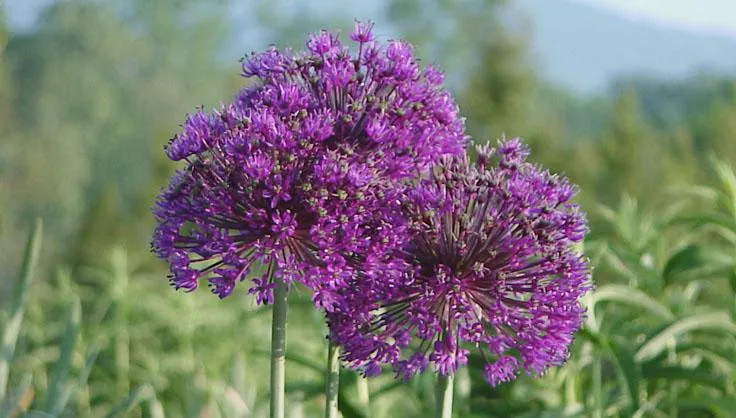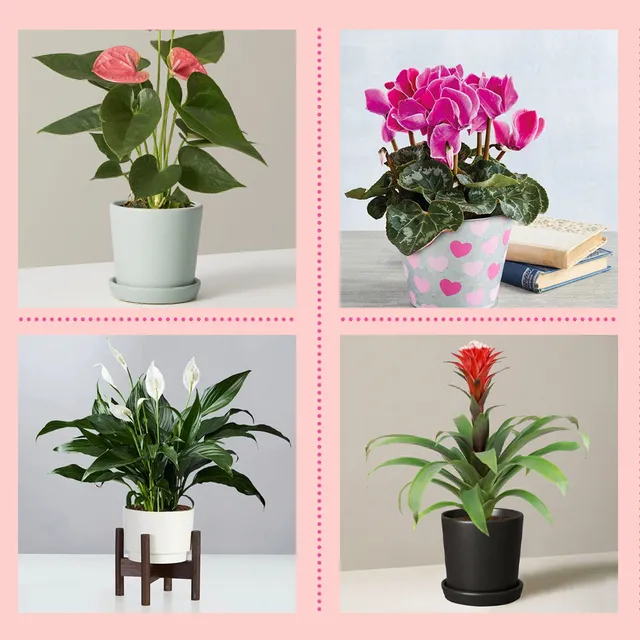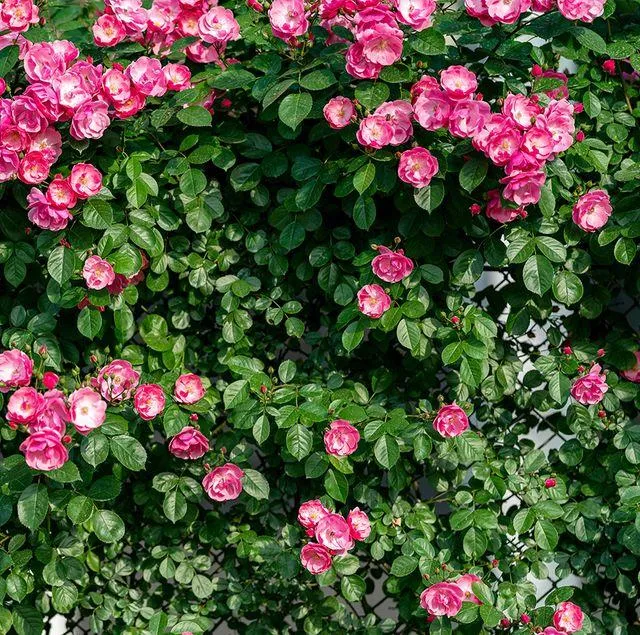15 Gorgeous Flower Varieties That Thrive Indoors
If you want to add a pop of color and natural beauty to your home but don’t have a green thumb, fear not. There are plenty of low-maintenance indoor flowers that will flourish with just a bit of care. From my experience caring for indoor plants, these 15 varieties are especially easy for beginners to grow.
1. Peace Lilies
- Peace lilies (Spathiphyllum) are basically foolproof. As long as they receive indirect sunlight and you keep the soil moderately moist, they’ll thrive for months. Thanks to their bold leaves and beautiful white blooms, peace lilies sort of have an majestic vibe.
- They’re also great air purifiers, filtering toxins like formaldehyde and benzene from the air. So growing peace lilies is like giving yourself a little spa treatment every day. My peace lilies have lasted years with very little fuss on my part.
2. Pothos
Pothos (Epipremnum aureum) is one of those nearly impossible-to-kill houseplants. It does well in low to medium light and can go long stretches without water when you forget. Pothos comes in several varietals with charming heart-shaped variegated leaves. The Manjula pothos has splashes of cream and shades of lime green—it’s simply stunning! Pothos vines can trail for yards, giving it a wild, romantic feel. I find it adds a lovely lush element to any space.
3. Snake Plants
Snake plants (Sansevieria trifasciata) live up to their reputation as one of the hardiest indoor flowers. This plant can basically survive nuclear fallout! I’ve seen snake plants thrive with almost no light, barely any water for months. They come in several varieties with thick grass-like leaves in tones like golden, grayish-blue, and solid dark green. Snake plants release moisture into the air, so they make a nice addition to a workspace. Just give them periodic water and forget about it—the plant will be good forever, no joke.
4. Chinese Evergreens
Chinese evergreen (Aglaonema) blooms may only last a few weeks but their foliage more than makes up for it. These dense-leaved beauties come in a kaleidoscope of colors like rose, lime, cream, and variegated. Chinese evergreens are fairly tolerant of lower light. But if you give them adequate indirect sunlight, oh man—their leaves will pop with vivid shades. Water just enough to keep the soil barely moist. Try the ‘Maria’ variety if you want pinkish-purple hues that will knock your socks off at a price that won’t break the bank.
5. Dracaenas
Dracaenas come in various tree-like shapes ranging from compact to moderately tall. Some of the hardier, more compact varieties include ‘Janet Craig’ compacta with its slender leaves splashed scarlet and yellow, and ‘Lemon Lime’ with broad green and yellow leaves. Dracaenas do well in low to medium light with occasional direct sun. Let the top inch of soil dry out between waterings. Dracaenas are so easygoing—just give them their space and they’ll reward you with lush tropical foliage for years.

6. Chrysanthemums
When it comes to bright, cheerful indoor flowers, chrysanthemums (Chrysanthemum morifolium) are an excellent choice. These proliferate in a range of colors from classic reds and pinks to eye-catching shades of orange, yellow, and purple. Best of all, chrysanthemums bloom for months on end, giving you constant flower power indoors. Give them bright, indirect light and keep the soil moist. Pinch off spent blooms to encourage reblooming. Seriously, these flowers are like sunshine in a vase—they’ll brighten any room with minimal effort.
7. African Violets
African violets (Saintpaulia ionantha) are pretty much the queens of low-light houseplants. Their charming blooms in pinks, purples, whites, and bi-colors stand out beautifully against their rosette leaves. Give African violets partial sun to shade. Water just enough to keep the growing mix lightly moist. They’re fussy about overwatering, so allow the top soil to dry out between waterings. Fertilize every few weeks for the best blooming display. With care, African violets will reward you with continuous blooms for months—truly a vibrant splash of color.
8. Orchids
Once considered highly delicate, modern orchid varieties have become vastly more tolerant of average home conditions. Phalaenopsis or moth orchids are an especially good choice as they thrive in medium light with periods of shade. Water when the growing medium (usually bark) appears dry, about once a week. Fertilize monthly during the growing season for prolific blooms in striking shades like cerise, peach, salmon, and pure white. With only moderate care, orchids will reward you with a tree of colorful blooms for 3 months or more—and show off your green thumb skills at the same time.
9. Jasmine
Nothing smells quite like the sweet floral fragrance of jasmine (Jasminum polyanthum). This twining vine bursts with delicate white blooms in summer. Give jasmine partial to full sun and keep the soil lightly moist. Pinch off spent blooms to encourage more bloom production. Train it onto a small obelisk or trellis for an upright habit. The intoxicating scent will waft throughout your home—a natural air freshener and cheery explosion of color, what’s not to love? With its ease of care and beauty, jasmine is a no-brainer indoor flower choice.
10. Gerbera Daisies
These vibrant blooms resemble oversized daisies in captivating hues spanning red, orange, pink, yellow and coral. Give gerbera daisies (Gerbera jamesonii) maximum light for buoyant blooms. Water generously when the top inch becomes dry. Snip individual flowers as they fade for continuing rebloom. Their large blossoms make quite a dramatic, cheerful display indoors. Gerbera daisies definitely brighten up a room and require minimal care—a real win-win flower.

11. Kalanchoe
Kalanchoe (Kalanchoe blossfeldiana) comes in a range of hybrid varieties with fuzzy succulent leaves and clustered blooms in shades like cherry red, apricot orange, salmon, yellow and fuchsia. Easy to propagate from leaf cuttings, kalanchoe are quite prolific bloomers over winter months. Give them bright light and keep the dry in between waterings. Their vivid blooms look amazing in a bowl—the perfect cheerful pick-me-up when darker days roll around. Low maintenance and long-flowering, kalanchoe are a top indoor flower choice.
12. Wax Begonias
For continuous color over many months, wax begonias (Begonia semperflorens) take the cake. These bushy plants coated in charming blooms come in colors spanning pale pink,orange coral, cherry red, deep rose, yellow, ivory and variegated. Pinch back stems to encourage branching and more blooms. Keep wax begonia soil lightly moist in a sunny spot. No garden needed with these obliging flowers—just tuck a wax begonia anywhere indoors for glorious blooms. Their ability to flower nonstop makes them one of the best indoor flowers around.
13. Hydrangeas
Who doesn’t love the huge round blooms on hydrangeas? Several compact cultivars adapt well as indoor flowers like ‘Nikko Blue’ dwarf hydrangea. Give them medium to bright light and keep the soil lightly moist. You can force blooms nearly year-round indoors just by trimming stems and placing them in water. So pretty yet almost impossible to kill, hydrangeas make a premium statement wherever you place them—an amazing indoor flower that really stands out.
14. Fuchsias
Talk about riotous blooms—fuchsias (Fuchsia hybrida) put on a real show. You can find bushy varieties in hot shades like orange, deep pink, coral, white tipped with purple and vibrant red. Give them maximum light for perpetual flowers over many months. Keep the soil lightly moist. Deadhead spent blooms to maintain constant blooms. Bask in their dazzling blooms indoors to brighten even the darkest corners—lovely leafy fuchsias are true
Flowers for Indoor Home Gardens
| Name | Bloom Time | Light Needs | Water Needs |
|---|---|---|---|
| Pothos | All year | Low | Let soil dry between waterings |
| Phalaenopsis Orchid | Spring to summer | Medium | Water weekly, let dry between |
| Chinese Evergreens | Spring to fall | Medium to low | Water when top inch of soil is dry |
| Peperomia | Spring to summer | Medium to low | Water when top inch of soil is dry |
| Snake Plants | Spring to fall | Low | Water every 2-4 weeks |
FAQ
-
What types of flowers do well indoors?
Plants like peace lilies, orchids,Chinese evergreens or pothos can survive indoors pretty easily. Basically anything that doesn’t need a ton of sunlight will do okay. Spider plants and bamboo palms are also kinds of resilient.

-
How often should indoor flowers be watered?
It sort of depends on the plant but as a general rule, you’ll want to check the soil every few days and water when the top inch gets dry. Certain flowers like orchids only need water when their moss is totally dried out. So you gotta play it by ear for every type.
-
What kind of light do indoor flowers prefer?
While some flowers can survive in low light, they’ll definitely thrive more with brighter conditions. Otherwise you might end up with anemic looking plants. Most gardeners recommend eastern or southern window exposure if possible. Nevertheless, under cabinite grow lights can also work excellent for plenty of houseplants when regular sunlight is lacking.
-
How can you encourage blooming for indoor flowers?
Providing the right growing conditions is crucial for coaxing blooms. Make sure plants get adequate humidity, drainage, and be careful not to overwater. You can also try moving flowers to a spot with more light during winter. According to expert horticulturists, maintaining consistent temperatures also appears to help trigger flowering.
-
What pests are common for indoor flowers?
Unfortunately fungus gnats, spider mites, and aphids sometimes plague home greenery. The good news is natural enemies like ladybugs may eat these pests. You can also make your own neem oil solution as an effective, non-toxic spray. On the other hand, preventative measures work best – like quarantining new plants and keeping areas dry.
-
How do you fertilize indoor flowers?
Using a balanced, water soluble fertilizer according to label directions is an easy way to feed your blooms. You’ll basically want to fertilize during the plant’s active growing season, usually spring through fall. Dilute fertilizer to 1/2 or 1/4 strength whenfirst starting out. That said, some folks claim compost tea provides similar nutrients in a more natural form.

-
Is growing flowers indoors worthwhile?
Even a small flower garden inside can be awfully rewarding. Houseplants not only spruce up a space, studies show they may reduce stress and boost mood too. Plus caring for greenery is a fun hobby. The joy of watching new growth or a bloom appear seems to make the effort of maintenance totally worth it. So in summary – hell yes, bring the outdoors in!
